Hickford's Long Room
Hickford's Long Room was a public concert room in London, which ran from April 1713 to about 1779.[1] It was paid for on a subscription basis to those who could afford to patronize the arts, such as the nobility.[2][3] The 1922 Groves noted that "most of the great performers, both vocal and instrumental, who visited England, gave their concerts there."[1] The room became a place to see successful musicians play, including Francesco Scarlatti (1719 & 1724)[4], Francesco Geminiani (c. 1732),[2] Gluck in 1746,[5] Mozart (1765),[6], Francesco Maria Veracini,[1] Pietro Castrucci[7] and Matthew Dubourg.[7] For a time in the 1740s and 50s, it was the only concert room of note in the West End of London.[8]
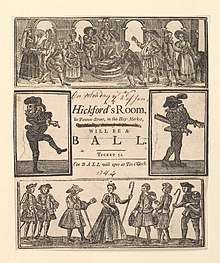
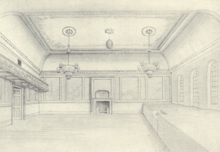
John Hickford
A 1922 source reports that "little is known" of the venue's founder, John Hickford.[1] He was a "dancing-master in the latter part Queen Anne's reign", and his room was one of two in the west end of London with sufficient room for concerts.[9] As artists approached him to use his room, he developed a reputation as a concert-organizing agent.[9] His establishment was known by a variety of names at different times, including Mr. Hickford's Dancing School and Mr. Hickford's Great Dancing Room.[1] Later as it became a concert venue, it was called Mr. Hickford's Great Room and Mr. Hickford's Room.[1]
Programme

There were 20 concerts a season, running from December to April. A season ticket (or "subscription") cost 4 guineas, about 44 days wages for a skilled tradesman.[2][10] Non-ticket holders paid half a guinea (6-days' wages) to attend a show if space was available.[2][10] A ticket-holder could arrange to bring a friend, with a charge of 5 shillings (2-days' wages) for each of them.[2][10]
The regular band was led by Michael Christian Festing, with singer Cecilia Young (known publicly as "Mrs. Arne") and cello played by Andrea Caporale (who played for Handel in 1740).[2]
In addition to the house's seasonal shows, benefits concerts were held for musicians, with other musicians supporting them with their music. An example of this was the benefit for mandolin virtuoso Gabriele Leone, March 17, 1766. The beneficiary, Leone, performed one of his own pieces, as well as one from Emanuele Barbella.[11] He had help from composer Mattia Vento, who directed the concert.[11] Also part of the concert was violinist composer François-Hippolyte Barthélémon and his soon-to-be wife, soprano Polly Young,[12] Joseph Tacet (who was a master of the German flute),[13], the Brothers Colla (playing colascione)s, Spanish violinist Oliver (whose patron was the Earl of Abingdon)[14] and cellist Giovanni Battista Cirri.[11]
Location
The Long Room was located first on James Street in Haymarket, across from the Royal Tennis Courts); it was expanded and grew to have a second entrance on Panton Street.[1] As Mr. Hickford became successful, he moved his establishment, in 1739, to Brewer Street near Golden Square, "a fashionable part of town."[4] The latter location featured a room 50 feet by 30 feet, lit by a large window on the southern side, with a high coved ceiling and decorative cornices and mouldings.[4] It had a small stage and a gallery above the door.[4] It is unclear whether Hickford had the new room built, or whether he took over an existing space.[8]
The room stood behind No. 41 Brewer Street until its demolition in 1934 as part of the expansion of the Regent Palace Hotel. The Encyclopaedia Britannica described the demolition has having a "deplorable disregard of its unique interest and historical associations".[8]
Gallery
 1719, Feb. Advertisement announcing Vocal and instrumental music for the benefit of Mr. Dahuron. Entrances on both James Street and Panton Street.
1719, Feb. Advertisement announcing Vocal and instrumental music for the benefit of Mr. Dahuron. Entrances on both James Street and Panton Street..jpg) 1737. Announcement of March 1737 concert for violinist, Mr. Zuccarini.
1737. Announcement of March 1737 concert for violinist, Mr. Zuccarini.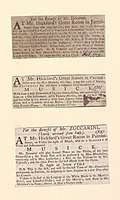 1737, March 25. Advertisements for Hickford's Great Room on Panton Street, about two years before the move to the Brewer Street location.
1737, March 25. Advertisements for Hickford's Great Room on Panton Street, about two years before the move to the Brewer Street location.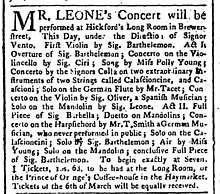 1766, March 17. Benefit concert Advertisement for Gabriele Leone at Hickford's Long Room.
1766, March 17. Benefit concert Advertisement for Gabriele Leone at Hickford's Long Room. 1772, April 2. Newscutting relating to Hickford's, announcing A grand concert for the benefit of Mr. Vento; Grand concert; Hickford's near Golden Square
1772, April 2. Newscutting relating to Hickford's, announcing A grand concert for the benefit of Mr. Vento; Grand concert; Hickford's near Golden Square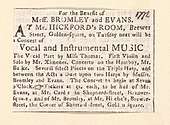 1772. Concert for the benefit of Mr. Bromley; Vocal part by Miss Thomas; First violin and solo by Mr. Ximenes; Concerto on the hautboy; Several select pieces on the harp; Duet upon two harps by Messrs. Bromley and Evans.
1772. Concert for the benefit of Mr. Bromley; Vocal part by Miss Thomas; First violin and solo by Mr. Ximenes; Concerto on the hautboy; Several select pieces on the harp; Duet upon two harps by Messrs. Bromley and Evans.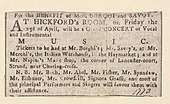 1773. Concert for the benefit of Mess. Borghi and Savoy.
1773. Concert for the benefit of Mess. Borghi and Savoy.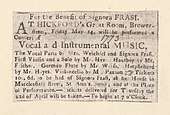 1773, May 14. Concert for the benefit of Signora Frasi.
1773, May 14. Concert for the benefit of Signora Frasi.
References
- Harrison 1922, pp. 393
- Harrison 1906, pp. 603
- "Mr. Leone begs pardon of the nobility". The Public Advertiser. London. 5 March 1766. p. 1. Retrieved 8 March 2019.
[article reveals something of the patrons of Hickford's Long Room; calls them "the Nobility & etc"
- Harrison 1922, pp. 395
- Zeitler, William. "The Glass Armonica, Benjamin Franklin's Magical Musical Invention". glassarmonica.com. Retrieved 8 June 2019.
- Harrison 1906, pp. 669
- Harrison 1922, pp. 394
- "Brewer Street and Great Pulteney Street Area". www.british-history.ac.uk.
- Harrison 1906, pp. 602
- "Currency converter: 1270–2017". nationalarchives.gov.uk. Retrieved 8 June 2019.
In 1720, you could buy one of the following with £1: ...Wages: 11 days (skilled tradesman) [1 guinea = 11 days labor, 4 guineas = 44 day's labor]
- "Mr. Leone's Concert". The Public Advertiser. London. 17 March 1766. Retrieved 8 June 2019.
- Olive Baldwin, Thelma Wilson: "Charles Young", Grove Music Online ed. L. Macy (Accessed 12 January 2009), (subscription access)
- "The compleat tutor for the German-flute : containing the easiest and most modern methods for learners to play, to which is added a favorite collection of song tunes, minuets, marches, duets, &c. Also the method of double tongueing and a concise scale and description of a new invented German-flute with additional keys such as play'd on by that celebrated master Mr. Joseph Tacet". archive.org. Retrieved 8 June 2019.
- Van Boer, Bertil H. (2012). Historical Dictionary of Music of the Classical Period. Scarecrow Press. p. 412. Retrieved 8 June 2019.
Bibliography
- Harrison, Bertha (1 September 1906). "A Forgotten Concert Room". The Musical Times. Vol. 47. London. pp. 602–605. Retrieved 7 June 2019.
- Harrison, Bertha (1 October 1906). "A Forgotten Concert Room (continued)". The Musical Times. Vol. 47. London. pp. 669–672. Retrieved 7 June 2019.
- Bertha, Harrison (1922). Maitland, J. A. Fuller (ed.). Grove's Dictionary of Music and Musicians. Philadelphia, Pennsylvania: Theodore Presser Company. p. 393-396.
hickford's long room.